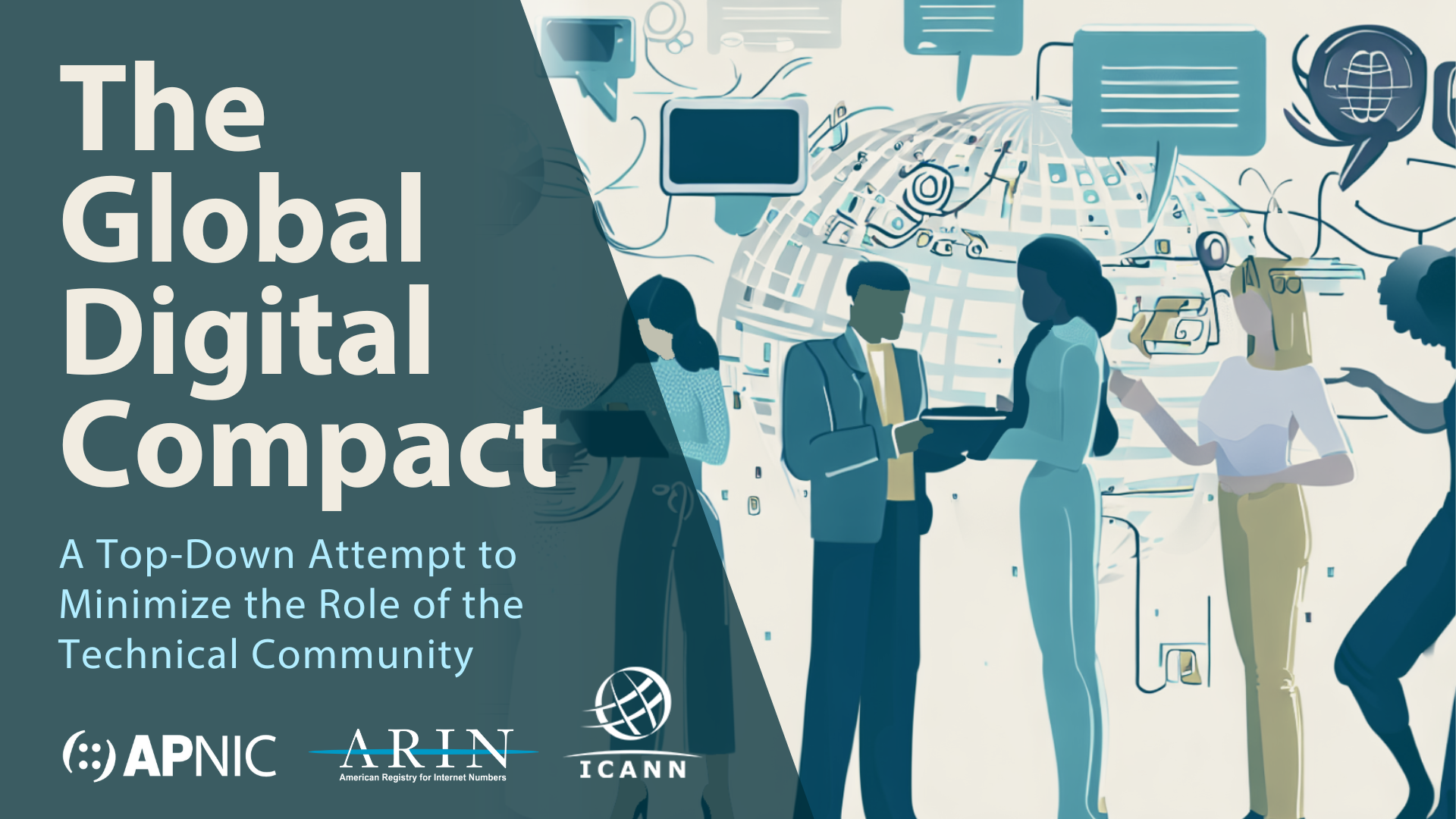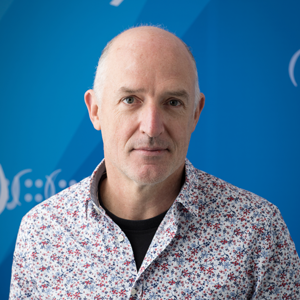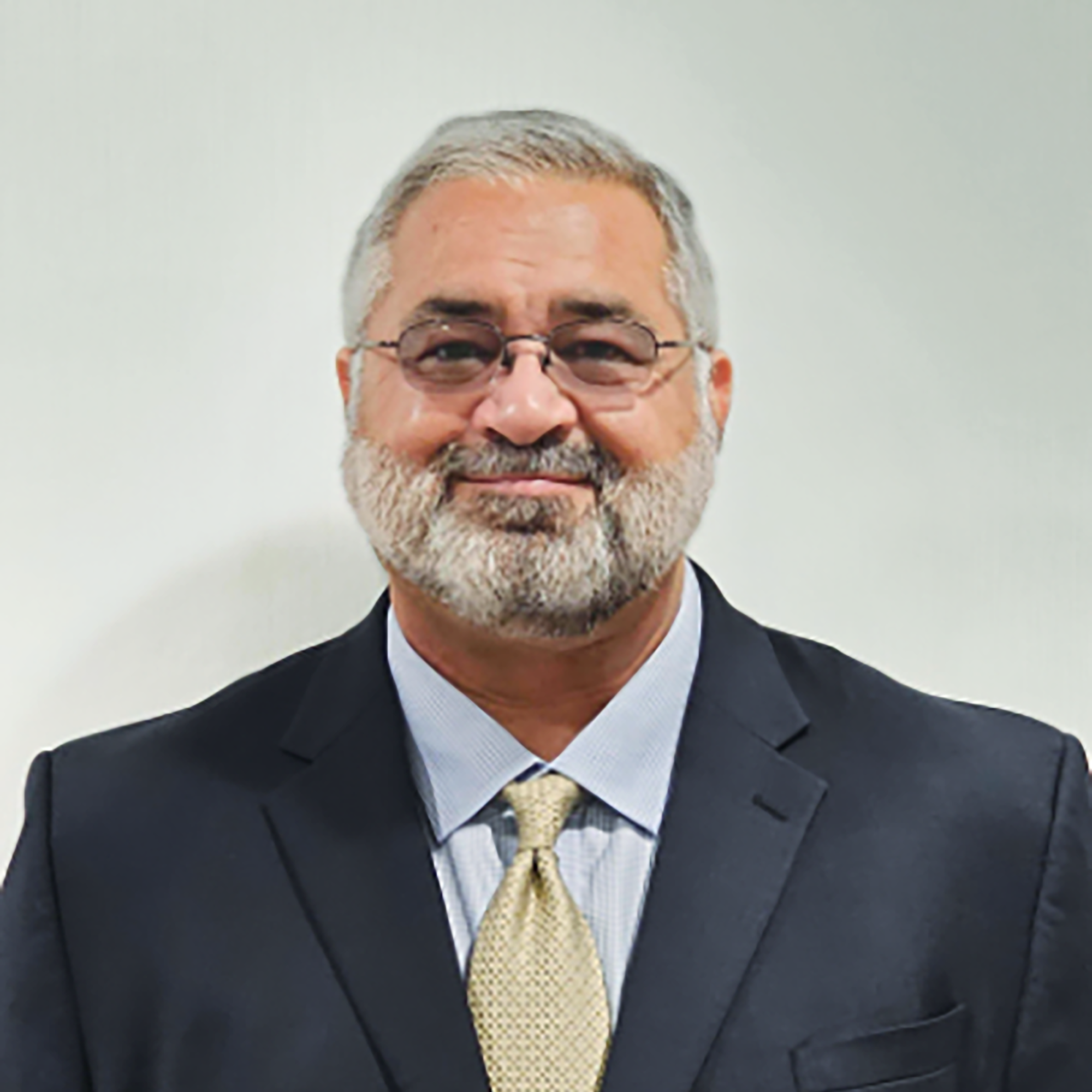
The Global Digital Compact: A Top-Down Attempt to Minimize the Role of the Technical Community
The following blog is co-authored by Sally Costerton, Internet Corporation for Assigned Names and Numbers (ICANN), Paul Wilson, Asia Pacific Network Information Centre (APNIC), and John Curran, American Registry for Internet Numbers (ARIN). It is intended to raise awareness of and highlight the technical community’s concerns about the United Nations (U.N.) Office of the Secretary-General’s Envoy on Technology’s (OSET) recent comments that appear to overlook an important distinction between the respective roles of the technical community and the civil society in the Internet ecosystem.
The technical community is responsible for the development and functioning of the single interoperable Internet. As such, it should not be confused with the other stakeholders in the multistakeholder model of Internet governance, which sets clear distinction between their roles and functions. It’s the cooperative balance between all of its stakeholders that keeps the Internet functioning.
The Global Digital Compact (GDC): A Top-Down Attempt to Minimize the Role of the Technical Community
The success of the Internet is the outcome of a well-established multistakeholder model of Internet governance that was described in the Working Group on Internet Governance (WGIG) report in 2005, further affirmed in the World Summit on the Information Society (WSIS) Tunis Agenda, and reaffirmed in the WSIS+10 Outcome Document. Among the essential components of that model identified in these documents is the technical community – a group of organizations and associated communities of interest that fulfill specific critical roles in relation to the daily technical functioning of the Internet. Collectively, the technical community shares an obligation to steward Internet resources, such as protocol development, unique identifiers management, core infrastructural components, and others, which result in its stable, reliable, and resilient operation.
The U.N. Secretary-General’s Policy Brief on the GDC
During the European Dialogue on Internet Governance on 19 June 2023, the United Nations Secretary-General’s Envoy on Technology (U.N. Tech Envoy) Ambassador Amandeep Gill stated,
”So the preparation [for the new Digital Cooperation Forum] — tripartite, so those words are clearly used across civil society, which includes all the actors from the technical community, academia, and the value of scientific, independent scientific expertise, particularly around AI, that is clearly understood today, there is private sector and there is governments.”
The U.N. Tech Envoy’s statement suggests that there is a new “tripartite” model for digital cooperation, in which there are only three stakeholder groups — the private sector, governments and civil society (which includes the technical community). In other words, this model excludes the technical community as a distinct component, and overlooks the unique and essential roles played by that community’s members separately and collectively.
This “tripartite” concept was introduced in the U.N. Secretary-General (UNSG) Policy Brief. Ambassador Gill provided a more detailed definition of what the OSET envisions. This concept seems to be based on a single mentioning of the word in the report by the High-Level Advisory Board on Effective Multilateralism (another body created by the UNSG). The report addresses the inclusion and obligations of the private sector (recommendation 3, p. 18). As for the technical community’s participation in these U.N. processes, the report mentions their “…regular, predictable and structured engagement from civil society, the private sector, academia and other technical entities, such as standards bodies…” (p. 41), and this is only used in the broader argument for why the Global Commission on Just and Sustainable Digitalization should be created under the UNSG umbrella.
Bringing Attention to Critical Matters
As participants in the technical community, we would like to raise awareness of this development and its attempt to change the multistakeholder model of Internet governance. The U.N. Tech Envoy’s European Dialogue on Internet Governance (EuroDIG) statement is a significant step back from the agreements made at WSIS, the WSIS Tunis Agenda, and the WSIS+10 Review Outcome Document.
The technical community is not part of civil society and it has never been; it is widely recognized in the WSIS process, which defined the roles and functions of each stakeholder engaged in the development of the Internet.
The WSIS Tunis Agenda recognizes the different stakeholders and their roles in paragraph 35:
“35. We reaffirm that the management of the Internet encompasses both technical and public policy issues and should involve all stakeholders and relevant intergovernmental and international organizations. In this respect it is recognized that:
a) Policy authority for Internet-related public policy issues is the sovereign right of States. They have rights and responsibilities for international Internet-related public policy issues.
b) The private sector has had, and should continue to have, an important role in the development of the Internet, both in the technical and economic fields.
c) Civil society has also played an important role on Internet matters, especially at community level, and should continue to play such a role.
d) Intergovernmental organizations have had, and should continue to have, a facilitating role in the coordination of Internet-related public policy issues.
e) International organizations have also had and should continue to have an important role in the development of Internet-related technical standards and relevant policies.”
Furthermore, the WSIS Tunis Agenda continues, in paragraph 36:
“36. We recognize the valuable contribution by the academic and technical communities within those stakeholder groups mentioned in paragraph 35 to the evolution, functioning and development of the Internet.”
In other words, the academic and technical communities are specific stakeholders that contribute to the work of each of the groups mentioned in paragraph 35.
The WSIS+10 Outcome Document is even more specific, as it states several times that the technical community is different from the civil society, e.g.:
“3. We reaffirm, moreover, the value and principles of multi stakeholder cooperation and engagement that have characterized the World Summit on the Information Society process since its inception, recognizing that effective participation, partnership and cooperation of Governments, the private sector, civil society, international organizations, the technical and academic communities and all other relevant stakeholders, within their respective roles and responsibilities, especially with balanced representation from developing countries, has been and continues to be vital in developing the information society.”
The WSIS+10 Outcome Document further mentions the technical community in points 2, 12, 49, 57, 61, 66, as well as the welcoming paragraph.
In these foundational documents there is no “tripartite” structure of the kind the U.N. Tech Envoy suggested. Furthermore, there is nothing setting out having only three participating groups in Internet governance.
Support for the Multistakeholder Model of Internet Governance
We pledge our support for the multistakeholder model of Internet governance, which was discussed at length – with full participation of all stakeholders – during the two phases of the WSIS and is reflected in the Report of the Working Group on Internet Governance (WGIG). The WGIG Report explains in detail the working and functioning of each of the “principal stakeholders” (see points 29 – 34 in the WGIG Report), explaining in particular that “…the technical community and its organizations are deeply involved in Internet operation, Internet standard-setting and Internet services development” (point 33). The civil society, on the other hand, has a distinct, separate role as described in point 32.
The WSIS and the follow-up WSIS+10 clearly affirmed the globally accepted multistakeholder model of Internet governance and determined the best way for further deployment and development of the Internet. While we are not in the position to directly influence internal U.N. Secretariat processes, we would like to raise awareness about the direction the GDC process is taking, and the risks involved in excluding the Internet technical community from its processes and discussions.
Finally, we must emphasize the success of the Internet today, and over the 20 years since the start of the WSIS process. When WSIS concluded in 2005, there were one billion Internet users around the globe. Today, there are more than five billion users, yet the Internet continues to evolve and adapt to the needs of humanity, most recently in our response to the unprecedented challenge of the COVID pandemic. This success must be recognized as an important testament not only to the Internet as a technological platform, but also to the prevailing multistakeholder model by which it has been governed.
The technical community will certainly continue to play its critical roles in the future of the Internet, and it behooves the U.N. to recognize this reality in its formulation of any future processes related to Internet governance.
Recent blogs categorized under: Internet Governance
GET THE LATEST!
Sign up to receive the latest news about ARIN and the most pressing issues facing the Internet community.
SIGN ME UP →Blog Categories
RPKI • Updates • Outreach • Internet Governance • Grant Program • Tips • IRR • IPv6 • Public Policy • Caribbean • Elections • ARIN Bits • Fellowship Program • Training • Security • Guest Post • Data Accuracy • Business Case for IPv6 • IPv4 • Customer Feedback





